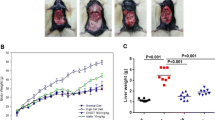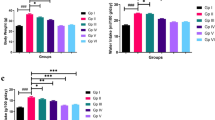Abstract
Objective
To determine the effects of hawthorn extract on serum lipid levels, pathological changes in aortic atherosclerosis plaque, inflammatory factors, and apoptosis-related protein and mRNA expression in apolipoprotein E gene knockout (ApoE-/-) mice.
Methods
Thirty-six ApoE-/- mice were fed with a high-fat diet starting at the age of 8 weeks. Mice were randomly divided into 3 groups by a random number table including model group, hawthorn extract group, and simvastatin group, 12 mice in each group. Twelve 8-week-old C57BL/6 mice were fed a basic diet and served as control. The mice in the control and model groups were administered 0.2 mL saline daily, the mice in the hawthorn extract and simvastatin groups were administered with 50 mg/kg hawthorn extract or 5 mg/kg simvastatin daily for 16 weeks. After 16 weeks, plasma lipids including total cholesterol (TC), triglyceride (TG), low-density lipoprotein cholesterol (LDL-C) and high-density lipoprotein cholesterol (HDL-C) were determined by an enzymatic assay. Aortic atherosclerotic lesions were observed by light microscopy, scanning and transmission electron microscopy, respectively. Plasma levels of monocyte chemoattractant protein-1 (MCP-1), interleukin-1β (IL-1β), adiponectin (APN), and hypersensitive C-reactive protein (hs-CRP) were measured by enzyme-linked immunosorbent assay (ELISA). Protein and mRNA expressions of Bax and Bcl-2 in the aorta were assessed by Western blotting and quantitative real-time polymerase chain reaction (qRT-PCR), respectively.
Results
Compared to the control group, the plasma levels of TC, TG and LDL-C were significantly increased and HDL-C were significantly decreased in the model group (P<0.01). Compared to the model group, treatment with hawthorn extract significantly decreased the plasma levels of TC, TG, and LDL-C and increased the plasma level of HDL-C in ApoE-/- mice (P<0.01). The levels of MCP-1, IL-1ß, and hs-CRP in the model group were significantly increased and APN was significantly decreased compared with the control group (P<0.01). Compared to the model group, treatment with hawthorn extract decreased the levels of MCP-1, IL-1ß, and hs-CRP and increased the APN level (P<0.01). Compared to the control group, the protein and mRNA expression of Bax in the model group were significantly increased and the expression of Bcl-2 was significantly decreased (P<0.01). Hawthorn extract also reduced the protein and mRNA expression of Bax and increased the Bcl-2 expression in the aorta (P<0.01).
Conclusion
Hawthorn extract has anti-atherosclerosis and stabilizing unstable plaque effects. The mechanism may be related to the inflflammation and apoptosis signaling pathways.
Similar content being viewed by others
References
Wang X, Li CY, Su LP, Zhou Y. Progress of pathogenesis and treatment of atherosclerosis. Pract J Card Cereb Pneum Vas Dis (Chin) 2017;25:1–4.
Libby P, Ridker PM, Hansson GK. Progress and challenges in translating the biology of atherosclerosis. Nature 2011;473:317–325.
Martinet W, De Meyer I, Verheye S, Schrijvers DM, Timmermans JP, De Meyer GRY. Drug–induced macrophage autophagy in atherosclerosis: for better or worse? Basic Res Cardiol 2013;108:321.
Mancini GB, Baker S, Bergeron J, Fitchett D, Frohlich J, et al. Diagnosis, prevention, and management of statin adverse effects and intolerance: Canadian Consensus Working Group update (2016). Can J Cardiol 2016;32:635–662.
Yu BB, Yan XS, Sun DD. Advances in pharmacological action and mechanism study of Hawthorn. Central South Pharm (Chin) 2015;13:745–748.
Liu LT, Zheng GJ, Zhang WG, Guo G, Wu M. Study on treatment of carotid atherosclerosis with extraction of Polygoni Cuspidati Rhizoma et Radix and Crataegi Fructus: a randomized controlled trial. Chin J Chin Mater Med (Chin) 2014;39:1115–1119.
Liu CL. Studies on the immunomodulation and cardioprotective effects of Hawthorn extract on mice [dissertation]. Xi’an: Fourth Military Medical University; 2006.
Peng FH, Ma X, Hu XY. Effects of Hawthorn extract on apoptosis and related factors of HepG2 cells. Chin J Exp Tradit Med Form (Chin) 2016;22:169–172.
Fredman G, Tabas I. Boosting inflammation resolution in atherosclerosis: the next frontier for therapy. Am J Pathol 2017;187:1211.
Zhao YK, Liu ZH, Mo ZQ. Absorptive effect and separating effect of macroporous adsorption resin on polydatin from Polygonum cuspidatum. Hunan Agricul Sci (Chin) 2011;41:123–126.
Kernan WN, Ovbiagele B, Black HR, Bravata DM, Chimowitz MI, Ezekowitz MD, et al. Guidelines for the prevention of stroke in patients with stroke and transient ischemic attack: a guideline for healthcare professionals from the American Heart Association/American Stroke Association. Stroke 2014;45:2160–2236.
Yin YJ, Zhang Q, Jia ZH, Zhang JF, Wang HT, Wei C, et al. Protective effect and its mechanism of Tongxinluo on vascular endothelial function in hyperlipidemic rabbits. Chin J Integr Tradit Weste Med (Chin) 2018;38:325–330.
Wang Q, Liu WX. A case of drug–induced myositis caused by simvastatin in intensive lipid–lowering therapy. J Cardiovasc Pulmon Dis (Chin) 2006;25:175.
Zhang B, Wang LL. Clinical application of statins and their major adverse effects. J Int Pharm Res (Chin) 2013;40:560–564.
Xu TJ. The effect of rosuvastatin on liver color ultrasound, ALT, AST and γ–GGT of nonalcoholic fatty liver disease. Chin J Integr Tradit West Med Dig (Chin) 2018;26:582–585.
Lou LJ, Luo JX, Gao Y. Overview of chemical compositions and pharmacological action of Grataegus pinnatifida Bunge. China Pharm (Chin) 2014;23:92–94.
Jurikova T, Sochor J, Rop O, Mlcek J, Balla S, Szekeres L, et al. Polyphenolic profile and biological activity of Chinese hawthorn (Crataegus pinnatifida Bunge) fruits. Molecules 2012;17:14490–14509.
Yang YJ, Lin J, Wang CM, Guo JJ. Experimental study on early intervention of total flavonoids from hawthorn leaves on hyperlipidemia in rats. Chin Tradit Herb Drugs (Chin) 2008;39:1848–1850.
Huang K, Yang XB, Huang ZM. Advances in pharmacological action of hyperin. Herald Med (Chin) 2009;28:1046–1048.
Li HZ, Huang QS, Chen WQ, Huang SX. Inhibitory effect of hawthorn extract on mutagenicity of human peripheral blood lymphocytes induced by hexavalent chromium. J Mathemat Med (Chin) 2005;18:590–592.
Lin Y, Vermeer MA, Trautwein EA. Triterpenic acids present in hawthorn lower plasma cholesterol by inhibiting intestinal ACAT activity in hamsters. Evid Based Complment Alterm 2011;2011:801272.
Lin K, Zhang TP, Zhu S, Wu C, Zhang HY. Immunological effects of ursolic acid from hawthorn fruits on hepatocellular carcinoma HepS cell in mice. Chin J Biochem Pharm (Chin) 2007;28:308–311.
Shen YJ, ed. Pharmacology of Chinese materia medica. Beijing: People’s Medical Publishing House; 2000:574.
Li JH, Hu JL. Pharmacological effect and clinical application of Hawthorn. Chin J Drug Abus Prev Treat (Chin) 2011;17:334–338.
Wang WH, Zhao HY, Chen WQ, Luo ZX, Yu XL, He QJ, et al. Effect of Shanzha Xiaozhi Capsule on high–sensitivity C–reactive protein and matrix metalloproteinases in patients with non–acute phase coronary heart disease of phlegm and blood stasis syndrome. Chin J Inf Tradit Chin Med (Chin) 2012;19:13–15.
Kuper C, Beck FX, Neuhofer W. Autocrine MCP–1/CCR2 signaling stimulates proliferation and migration of renal carcinoma cells. Oncol Lett 2016;12:2201–2209.
Li Q. Effects of different doses of risuvastatin on the level of SAA hs–CRP in atherosclerotic rats. Contemp Med (Chin) 2012;18:131–132.
Wu YH, Sun JW, Chi TH. Mechanism of NLRP3/Casepase–1/IL–1 beta signaling pathway in pathogenesis of atherosclerosis in rats. Chin Heart J (Chin) 2018;30:141–145.
Yi Q, Li Y, Guo ZH, Liu L, Zhang JY, Ren X, et al. Effects of Xin Tong–tai on blood lipid, ox–LDL and IL–1β in aorta of rabbits with atherosclerosis. Chin J Atheroscler (Chin) 2016;24:39–43.
Kyriazi E, Tsiotra PC, Boutati E, Ikonomidis I, Fountoulaki K, Maratou E, et al. Effects of adiponectin in TNF–α, IL–6 and IL–10 cytokine production from coronary artery disease macrophages. Horm Metab Res 2011;43:537–544.
Zhang ZJ, Jia SB, Hou JJ, Liu J, Wang H, Li L. The expression of Bcl–2 and Bax in aorta of rats with hyperhomocysteinemia. Guangdong Med J (Chin) 2013;34:1160–1162.
Bao XM, Zheng HC. Effect of homocysteine on proliferation and migration of rat vascular smooth muscle cells and its possible mechanism. Shandong Med J (Chin) 2015;55:25–27.
Author information
Authors and Affiliations
Corresponding author
Additional information
Supported by the National Natural Science Foundation of China (No.81573821), General Financial Grant from China Postdoctoral Science Foundation (No. 2016M600176) and Special Financial Grant from China Postdoctoral Science Foundation (No. 2017T100147)
Rights and permissions
About this article
Cite this article
Wang, Sz., Wu, M., Chen, Kj. et al. Hawthorn Extract Alleviates Atherosclerosis through Regulating Inflammation and Apoptosis Related Factors: An Experimental Study. Chin. J. Integr. Med. 25, 108–115 (2019). https://doi.org/10.1007/s11655-018-3020-4
Accepted:
Published:
Issue Date:
DOI: https://doi.org/10.1007/s11655-018-3020-4




